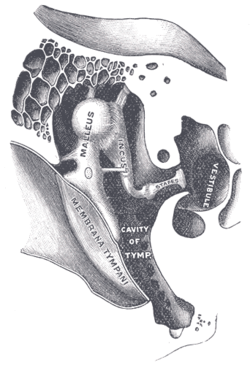| Prussak's space | |
|---|---|
 The right membrana tympani with the hammer and the chorda tympani, viewed from within, from behind, and from above. | |
 Chain of ossicles and their ligaments, seen from the front in a vertical, transverse section of the tympanum. | |
| Anatomical terminology |
In human anatomy, Prussak's space is the small middle ear recess, bordered laterally by the flaccid part of Shrapnell's membrane, superiorly by the scutum (a sharp bony spur that is formed by the superior wall of the external auditory canal) and lateral malleal ligament, inferiorly by the lateral process of the malleus, and medially by the neck of the malleus. From the neck of the malleus, the anterior malleolar fold and the anterior ligament arise, demarcating Prussak's space anteriorly. Ventilation of Prussak's space is only possible posteriorly above the posterior malleus fold.
It communicates with the posterior pouch of von Troltsch.[1]
It is named after the Russian otologist Alexander Prussak (1839-1897).[2][3][4]
- ^ Palva T, Ramsay H, Böhling T (July 1996). "Prussak's space revisited". Am J Otol. 17 (4): 512–20. PMID 8841695.
- ^ synd/3562 at Who Named It?
- ^ Alexander Prussak in Archiv für Ohrenheilkunde, 1867, 3: 255.
- ^ Palva T, Northrop C, Ramsay H (January 2001). "Aeration and drainage pathways of Prussak's space". Int. J. Pediatr. Otorhinolaryngol. 57 (1): 55–65. doi:10.1016/S0165-5876(00)00443-2. PMID 11165643.